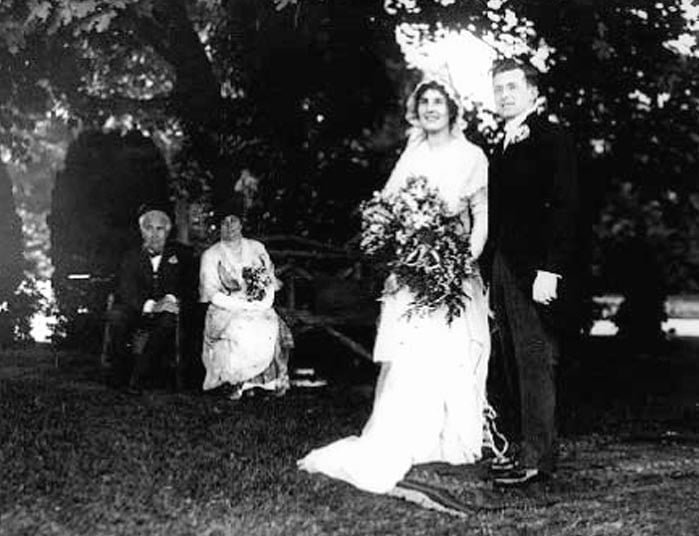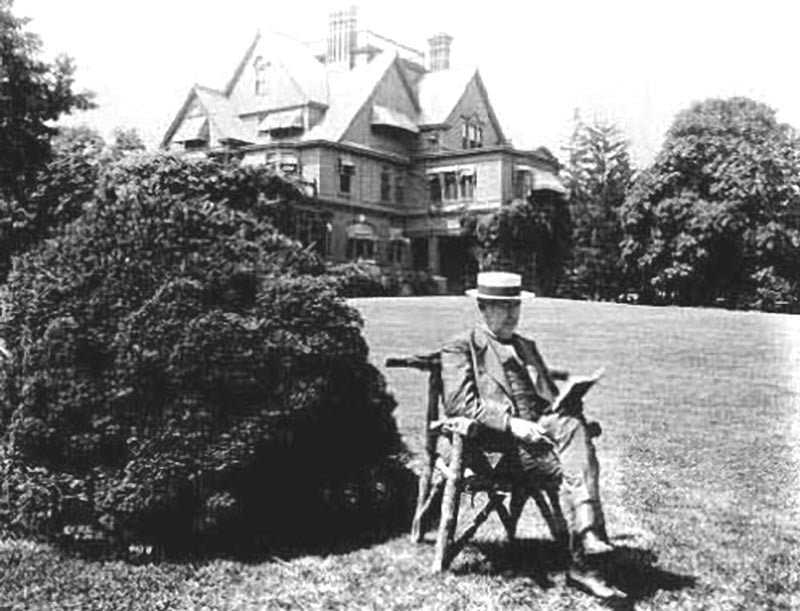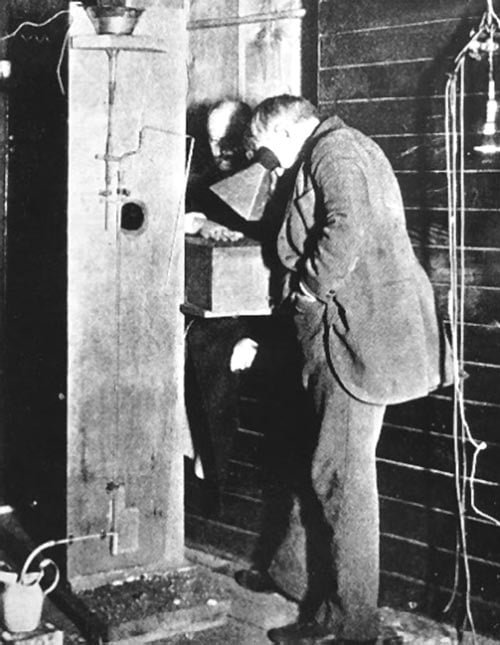It is true that Edison did not invent anything directly for the benefit of the present day world. The reason is simple, he was born 161 years back and more than 88 years have gone by since he died. Still in the field of inventions and research the name of Thomas Edison shines bright. By dint of his organisational capabilities Edison played a leading role in strengthening the US and world markets with communication works, power systems and entertainment industry. His very name has become synonymous to research and inventiveness.
In west a boy fiddling with gadgets or implements is often asked, ‘Hello young Edison! What new invention you are working upon?” It is the situation 80 years after the death of Thomas Edison. That 80 year time gap suddenly vanishes when we try to think of the best example of inventiveness to compare an inquisitive child with.
His inventive creativity is depicted as a lit up electric bulb, his famous invention. Some graphic character hitting upon a brilliant idea is again illustrated as switched on bulb above the head of a character by cartoonists. His bulb is the symbol of brilliant mind, inentiveness or a great idea. That is ‘Edison Bulb’ as artists or cartoonists love to call it. Every Literate person must have seen that bulb in a cartoon, comic book or in some graphic depiction. Even advertisements about a new product try to use the inventiveness of Edison directly or by indirect reference. As an inventor Edison himself has become a patent item as the first and the last choice. The use of Edison bulb makes an idea great or brilliant. Edison is a trademark. His 1093 patents registered in USA have not faced a single challenge from anyone so far and do not look likely in near or far future too.

One natural question arises that what Thomas Edison had that other inventors did no have? What set him apart? By the basic reckoning Edison was a clever and wise inventor. But so were many other contemporary inventors and scientists. Yet the people have almost forgotten them. Infact, his massive inventive output and his talent to commercialise it dwarfed the achievements of his contemporaries. He gave his innovative ideas a practical shape more cleverly and speedily than others. Thomas Edison was a multi-dimensional character. His visualisation was also multi-dimensional. His thinking and ideas were more in tune with the necessities of the 20th century to which he introduced the novel ideas of research, invention development, upgradation and commercialisation Edison through his intellectual genius polished the concept of economisation and used press media to propagate his inventions and innovations or ideas successfully.

After gaining achievements Thomas Edison underlined his learning days in those words—”My mother taught me how to read books quickly and correctly, and as this opened up a great world in literature, I have always been very thankful for this early training.”
It was his mother who was his true guide and teacher in early learning years. She knew the handicaps of her child whom institutions like schools would not understand or care to understand. They had little time to pay attention to the individual and personal problems of their students. Thomas needed careful and sympathetic understanding which his mother provided.
Thomas had also assimilated the great industriousness of his father in his character. His father Samuel had run several businesses in his life. He had treaded in property deals, goods sales, distribution and undertaken carpentry assignments. Thomas had inherited the spirit of hard work from his father. A biographer of Edison has noted—
“A lively disposition always looking on the bright side of things and full of most saguine speculation as to any project he takes in his head.”
The above value had become motto of the life of Thomas Edison in later years.

The first duty of Thomas Edison as a boy was to lend a helping hand in tending the family garden. But sowing seeds in blazing sun was not an attractive prospect. So, in 1859 when Grand Trunk Railroad was extended from Port Heuren to Detroit young Thomas gained self generated employment as toffee vendor. He started selling newspapers and magazines to the passengers as he saw they wanted and needed them to pass time. Thomas showed his business sense by hiring boys to sell vegetables and newspapers. Then he noticed the passengers needed to know the timings of train arrival and departures. He began to publish a weekly bulletin containing Railway Time Table of Grand Trunk Trains. The work involved writing, editing, printing and distribution, A 12 year old Thomas Edison handled all those jobs. When ‘Shiloh’ related news arrived at detroit during the American civil war, Edison procured extra copies of a newspaper from its editor. With the hot selling newspaper copies he sold his railway Time Tables also. Due to increasing passenger volume the Time Tables had suddenly gained importance. Thomas Edison earned good money from this venture. It becomes clear that at a very early stage of his life Edison had realised the power of press, railways and the telegraph.
Alongside these railways ventures Edison continued his studies with equal seriousness and heart. After a busy day Edison would go to Detroit Public Library to study books of his special interest.

In one year Thomas Edison learnt the Telegraphy ropes and as a trained person worked as ‘Roving Telegrapher’ for the next four years. The imaginative Thomas Edison had opened the doors of Technological access to fulfil his ambitions and cherished desires in fields of research and invention. During those years he had become a top ranked telegrapher. He specialised as Press Wire Operator and gained recognition as the best. He could wire long and important messages very
efficiently. For this reason the editors and correspondents liked him and cooperated with him. In their morning meetings. Thomas Edison used to be present as a special guest. Many of his fellow telegraphers later became correspondents or journalists. But Thomas Edison had other ideas.
He worked in big cities of centre-west that were advanced in technology, commerce and political manipulations. Thomas studied technological and science books, mulled over journals on telegraphy and learnt a lot about electrical experiements and theories of Michael Farade. He sensed the heady feeling of inventions. After contemplation and self introspection Thomas Edison invented his new instruments and theories. Through his instruments and batteries Edison spread the light of science to new areas. He also gave thoughts to past visualisations and scientific concepts. He refined, redifined and upgraded them to make them practically useful. He even redeemed some rejected ideas by refining and reinventing them. To realise his dreams Thomas brought a small lathe machine to create his own implements.
In 1867 when foot-loose Thomas Edison turned towards his home he had already become familiar with the basics of science, an expert telegrapher and now he was ready for delving in inventions to realise his potential meaningfully.
A message from a telegraph operator pal brought Edison to Boston in 1868 and got a job in Western Union. It was in Boston where Edison saw the telegraph community in full strength with all its works, aspects and wings. There were master operators, top inventors, scientists, technicians, manufacturers of telegraphic implements, experimental machines, important industrialists and financers. Edison felt that they all were waiting for new inventors and inventions. The Boston atmosphere suited the mindset of Edison. His dream world was there in Boston. He worked in Western Union for a year and worked on various telegraph machines. Edison got aquainted with financers who could make his dreams come true.
After one year, Edison was able to gain a work place from Charles William, a prominent telegraph products manufacturer. He also arranged for facility to Edison in the residential laboratory of the famous inventor in electrics Mosser Farmer. For one year he worked there and patented two new inventions in his name. One of them was Electric Vote Recorder (which was rejected by State Council) and another was Printing Telegraph used in stock quotation services. After patenting those inventions he resigned from his post of Telegraph Operator in January 30, 1869. He wanted to work full time on new inventions.

In the spring of 1869 Thomas Edison turned towards New York with his new invention ‘Double Transmitter Telegraph’ to get it tested at the practical commercial level to assess its true worth. The people connected to the telegraphy field were consulted. The Western Union had its head office in Manhatten N.Y. Naturally the legal heads of telegraph industry, investor banks and inventors were there in the business centre. Edison teamed up with a telegraph engineer called Franklin Pope and started working in partnership. They were able to gain these profitable business contracts in printing telegraph field. They created a niche for themselves in financial information transmission business. Nine months later, Western Union and Gold & Stock Co. also contracted them for the supply of Printing Telegraph and Faximile (Fax) System.
The income generated by the Faximile was invested in setting up a laboratory in New Jersey by Thomas Edison. In this venture he included a mechanic called William Anger. This lab always remained his work place and became a symbol of Edison’s inventive spirit.

The working style of Thomas Edison was unique in the sense that he worked upon several projects at a time. In 1870 on one hand he was working on the faximile telegraph and at the same time he was on automatic telegraph. He never concentrated on one project. So multi-dimensional his mind was! When Edison was working on electric light, he faced several problems and snags but undeterred by those hurdles he started the work of producing a new range of the telephone receivers and ore separation unit. This multi-dimensional nature of his mind kept throwing up new ideas and he never wasted those ideas. He put them to good use in all his sincerity and farsightedness. His intellectual insight could at once realise which research idea could lead to what type of invention.

The relentless endeavour has the advantage of gaining some achievements as spin offs or as fringe benefits. The field of research is such that a person working on a project often gets a spin off idea for a new research. In this process Thomas Edison used to travel through his systems and instruments from one inventive point or search door to another as a continuous voyage. That was the secret behind his overtaking other inventors and researchers. He overtook all his contemporaries never allowing anyone to catch up with him.

Because of this by 1870 Thomas Edison had become leading telegraphic inventor of USA. In the same year in October some companies tried to transgress into the exclusive zone of Edison . They included some financers also. A company by the name ‘Automatic Telegraph’ was set up. Even then Edison set up a workshop having advanced technology by the name American Telegraph Works. In May, 1871 Gold & Stock Company appointed him its Electric and Technical Advisor. In 1877 Edison travelled to Britain and sold the rights of automatic telegraph system to a British syndicate. Under an oral contract Edison upgraded various telegraph systems in 1873 and 1874 for William Orton, the president of Western Union.
In 1875 Edison had to face a legal challenge. But undeterred by it in the same year he invented a telegraph system that could transmit four messages at a time. At that point of time it was a miracle act. Then American Chief Credit Reporting Agency and R.G.N. & Co. in agreement with the telegraph industry awarded the title of ‘Genius of the Telegraph’ to Thomas Alva Edison. It was a great honour and every one took note of Edison. He had become a famous name, an envy of other inventors.
During those years Gold & Stock Co. president Orton and Marshal Leffarts proved important people for Edson. Not only they facilitated the research work of Edison but provided very useful guidances as well. Leffarts was the one who briefed him on Patent rules and advised him to register his researches and new inventions in the patented list to safeguard the rights. He made Edison realise how patent could serve as a weapon to protect his intellectual and commercial rights. The same gentleman introduced Edison to Lemual Cerel who was a famous lawyer in patent laws. Edison kept in close touch with him for the next ten years and learnt how researches and inventions could be patented correctly without leaving any loopholes for others to exploit. Leffarts also introduced Edison to investors and financers who could be useful for him. As far as Orton was concerned he respected the inventions of Edison but more than that he had a special affection for the young inventor. Later, Edison joined hands with a competitor that Leffarts would not approve of, but he did not break their relationship which stayed till the end. Leffarts died in 1876 and two years later in 1878 Orton passed away. Then, Edison remarked, ‘If I get to love a man he dies right away. Lefferts went first and now Orton’s gone too.’ The readers can understand how much Thomas Alva Edison valued his relationship and association with the two dead ones. He respected and loved them.
Certain reactions of Edison betray his feeling about his wives in relation to his laboratory research work. By 1871 Edison had achieved a brief success in the business world of market and research works. Here he come into contact with 16 year old Mary Stilwell who had joined his office to work in business news section. Edison fell in love with her and two months later on X-mas day they got married. In 1872, on one February day Edison noted in his laboratory note book in disappointed mood, “Mrs Mary Edison my wife, dearly loved can not invent worth a damn.”
That is the only comment Edison made on Mary about her scientific calibre all through their marital life of 13 years till her death. Perhaps Edison had expectations of Mary to take interest in lab work and assist in his research work. But Mary showed no interest in laboratory or research work. She was a woman totally dedicated to the family. For Mary nothing mattered except family.
But in Edison’s diary the name of Mina Miller was noted in a different light. She came from a class family and was educatedly intelligent. In 1886, the year of their honeymoon several notings were made in the note books under her signature. For some months after their marriage Mina had noted the results of ‘lamp tests’ in the note book that were conducted in the lab, although Mina had not invented anything on her own or made any discovery. Even after his second marriage most of the time of Edison was taken up by his lab and he had little time for his children however he may had been affectionate to them by heart. He had assured Mina, ‘You and the children and the laboratory is all my life. I have nothing else.’
He had no time for extra-marital or extra-professional indulgences of any kind. He was dedicated to his laboratory, research work, wife and through her to his children. And that was his entire world.

